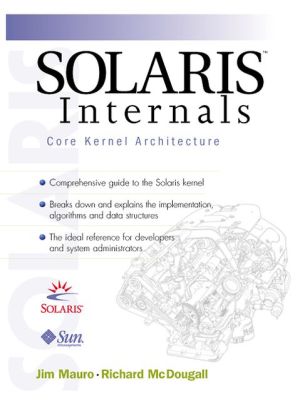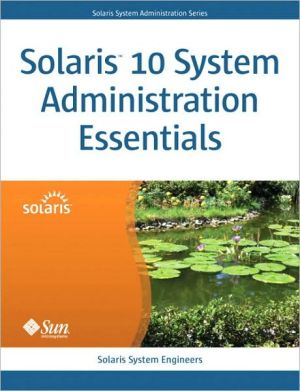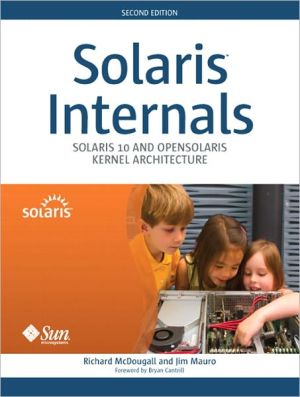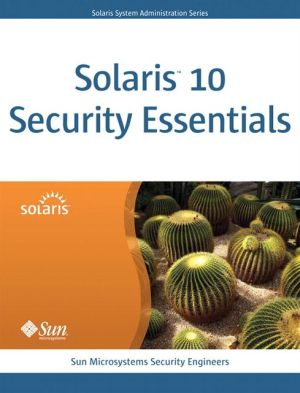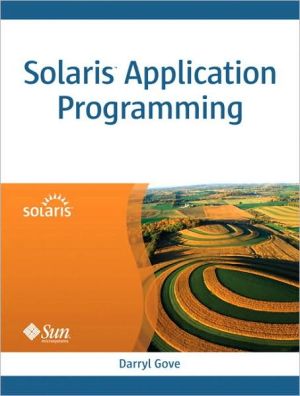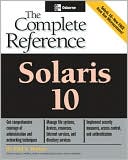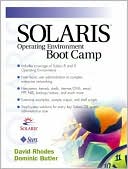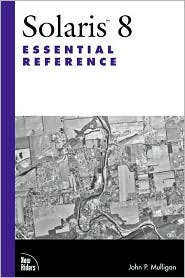Solaris(tm) Internals, Vol. 1
The definitive Sun Microsystems guide to the internals of the Solaris kernel.\ This book focuses on the core kernel functions, major data structures and algorithms. Its practical approach makes it an essential resource for anyone responsible for kernel, driver or application software. Anyone doing development, debugging, maintenance, performance tuning, capacity planning, or application tuning will also benefit from Mauro and McDougall's in-depth coverage of the Solaris kernel.\ This...
Search in google:
(Sun Microsystems) A definitive guide to the internals of the Solaris kernel, focusing on core kernel functions, major data structures, and algorithms. An indispensable reference for kernel developers, containing useful information for monitoring and optimizing Solaris systems. Booknews Focuses on core kernal functions, major data structures, and algorithms, for those responsible for kernal, driver, or application software. Covers key components that comprise the Solaris kernal, discussing the modular architecture of the kernal and each major subsystem. Topics covered include scheduler implementation and behavior, the Solaris multi-threaded architecture, and techniques for analyzing kernal behavior. Mauro has 20 years of experience with UNIX systems. McDougall is an engineer at Sun Microsystems. Annotation c. Book News, Inc., Portland, OR (booknews.com)
PREFACE: \ PREFACE\ The internals of the UNIX kernel are fairly well-documented, most notably by Goodheart and Cox 10, Bach 1, McKusick et al. 19, and Vahalia 39. These texts have become a common source of reference information for those who want to better understand the internals of UNIX. However little has been written about the specifics of the Solaris kernel.\ The paucity of Solaris specific information led us to create our own reference material. As we published information through white papers, magazine columns, and tutorials, the number of folks expressing interest motivated us to produce a complete work that discussed Solaris exclusively.\ About This Book\ This book is about the internals of Sun's Solaris Operating Environment. The rapid growth of Solaris has created a large number of users, software developers, systems administrators, performance analysts, and other members of the technical community, all of whom require in-depth knowledge about the environment in which they work.\ Since the focus of this book is the internals of the Solaris kernel, the book provides a great deal of information on the architecture of the kernel and the major data structures and algorithms implemented in the operating system. However, rather than approach the subject matter from a purely academic point of view, we wrote the book with an eye on the practical application of the information contained herein. Thus, we have emphasized the methods and tools that can be used on a Solaris system to extract information that otherwise is not easily accessible with the standard bundled commands and utilities. We want to illustrate how you can apply thisknowledge in a meaningful way, as your job or interest dictates.\ To maximize the usefulness of the text, we included specific information on Solaris versions 2.5.1, 2.6, and Solaris 7. We cover the major Solaris subsystems, including memory management, process management, threads, files, and file systems. We do not cover details of low-level I/O, device drivers, STREAMS, and networking. For reference material on these topics, see "Writing Device Drivers" 28, the "STREAMS Programming Guide" 29, and "UNIX Network Programming" 32.\ The material included in this book is not necessarily presented at an introductory level, although whenever possible we begin discussing a topic with some conceptual background information. We assume that you have some familiarity with operating systems concepts and have used a UNIX-based operating system. Some knowledge of the C programming language is useful but not required.\ Because of the variety of hardware platforms on which Solaris runs, it is not practical to discuss the low-level details of all the different processors and architectures, so our hardware focus, when detail is required, is admittedly UltraSPARC-centric. This approach makes the most sense since it represents the current technology and addresses the largest installed base. In general, the concepts put forth when detail is required apply to other processors and platforms supported. The differences are in the specific implementation details, such as per-processor hardware registers.\ Throughout the book we refer to specific kernel functions by name as we describe the flow of various code segments. These routines are internal to the operating system and should not be construed as, or confused with, the public interfaces that ship as part of the Solaris product line-the systems calls and library interfaces. The functions referenced throughout the text, unless explicitly noted, are private to the kernel and not callable or in any way usable by application programs.\ Intended Audience\ We hope that this book will serve as a useful reference for a variety of technical staff members working with the Solaris Operating Environment.\ \ Application developers can find information in this book about how Solaris implements functions behind the application programming interfaces. This information helps developers understand performance, scalability, and implementation specifics of each interface when they develop Solaris applications. The system overview section and sections on scheduling, interprocess communication, and file system behavior should be the most useful sections.\ Device driver and kernel module developers of drivers, STREAMS modules, loadable system calls, etc., can find herein the general architecture and implementation theory of the Solaris Operating Environment. The Solaris kernel framework and facilities portions of the book (especially the locking and synchronization primitives chapters) are particularly relevant.\ Systems administrators, systems analysts, database administrators, and ERP managers responsible for performance tuning and capacity planning can learn about the behavioral characteristics of the major Solaris subsystems. The file system caching and memory management chapters provide a great deal of information about how Solaris behaves in real-world environments. The algorithms behind Solaris tunable parameters (which are detailed in Appendix A) are covered in depth throughout the book.\ Technical support staff responsible for the diagnosis, debugging, and support of Solaris will find a wealth of information about implementation details of Solaris. Major data structures and data flow diagrams are provided in each chapter to aid debugging and navigation of Solaris Systems.\ System users who just want to know more about how the Solaris kernel works will find high-level overviews at the start of each chapter.\ \ In addition to the various technical staff members listed above, we also believe that members of the academic community will find the book of value in studying how a volume, production kernel implements major subsystems and solves the problems inherent in operating systems development.\ How This Book Is Organized\ We organized Solaras Internals into several logical parts, each part grouping several chapters containing related information. Our goal was to provide a building block approach to the material, where later sections build on information provided in earlier chapters. However, for readers familiar with particular aspects of operating systems design and implementation, the individual parts and chapters can stand on their own in terms of the subject matter they cover.\ \ Part One: Introduction to Solaris Internals\ \ \ Chapter 1 — An Introduction to Solaris\ Chapter 2 — Kernel Services\ Chapter 3 — Kernel Synchronization Primitives\ Chapter 4 — Kernel Bootstrap and Initialization\ \ \ Part Two: The Solaris Memory System\ \ \ Chapter 5 — Solaris Memory Architecture\ Chapter 6 — Kernel Memory\ Chapter 7 — Memory Monitoring\ \ \ Part Three: Threads, Processes, and IPC\ \ \ Chapter 8 — The Solaris Multithreaded Process Architecture\ Chapter 9 — The Solaris Kernel Dispatcher\ Chapter 10 — Interprocess Communication\ \ \ Part Four: Files and File Systems\ \ \ Chapter 11 — Solaris Files and File I/O\ Chapter 12 — File System Overview\ Chapter 13 — File System Framework\ Chapter 14 — The UNIX File System\ Chapter 15 — Solaris File System Cache\ \ \ \ Solaris Source Code\ In February 2000, Sun announced the availability of Solaris source. This book provides the essential companion to the Solaris source and can be used as a guide to the Solaris kernel framework and architecture.\ It should also be noted that the source available from Sun is the Solaris 8 source. Although this book covers Solaris versions up to and including Solaris 7, almost all of the material is relevant to Solaris 8.\ Updates and Related Material\ To complement this book, we created a Web site where we will place updated material, tools we refer to, and links to related material on the topics covered. The Web site is available at ...
ContentsList of FiguresList of TablesList of Header FilesPrefaceAcknowledgmentsPt. 1Introduction to Solaris Internals11An Introduction to Solaris32Kernel Services273Kernel Synchronization Primitives594Kernel Bootstrap and Initialization103Pt. 2The Solaris Memory System1235Solaris Memory Architecture1256Kernel Memory2057Memory Monitoring233Pt. 3Threads, Processes, and IPC2558The Solaris Multithreaded Process Architecture2579The Solaris Kernel dispatcher34310Interprocess Communication421Pt. 4Files and File Systems46911Solaris Files and File I/O47112File System Overview51313File System Framework53114The UNIX File System56515Solaris File System Cache589App. AKernel Tunables, Switches, and Limits609App. BKernel Virtual Address Maps621App. CA Sample Profs Utility629Bibliography635Index639
\ BooknewsFocuses on core kernal functions, major data structures, and algorithms, for those responsible for kernal, driver, or application software. Covers key components that comprise the Solaris kernal, discussing the modular architecture of the kernal and each major subsystem. Topics covered include scheduler implementation and behavior, the Solaris multi-threaded architecture, and techniques for analyzing kernal behavior. Mauro has 20 years of experience with UNIX systems. McDougall is an engineer at Sun Microsystems. Annotation c. Book News, Inc., Portland, OR (booknews.com)\ \
